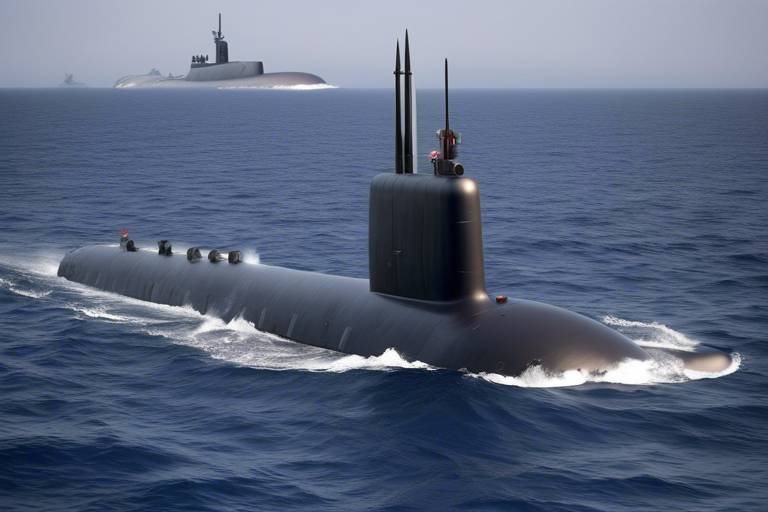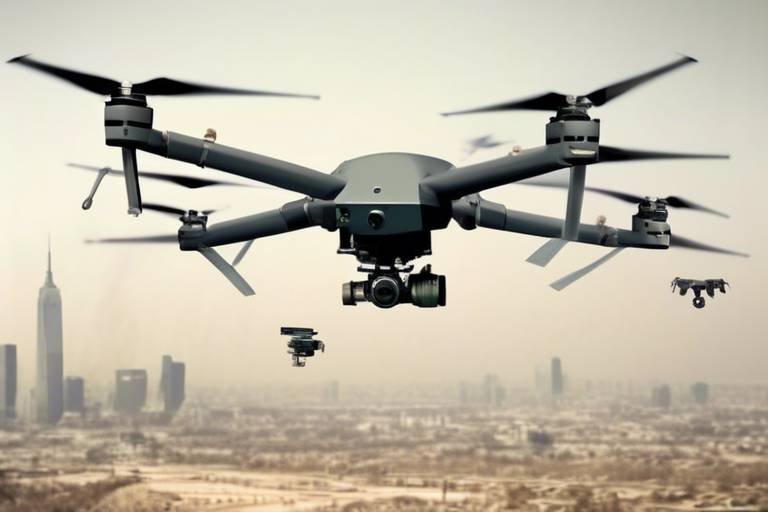The Future of Underwater Warfare - Submarine Missile Systems
As we delve into the future of underwater warfare, it's impossible to ignore the pivotal role that submarine missile systems play in shaping naval strategies across the globe. These silent giants of the deep have evolved from simple torpedoes to complex, multi-faceted platforms capable of launching devastating missile strikes from beneath the ocean's surface. The advancements in technology have not only enhanced their operational capabilities but have also fundamentally altered the landscape of military power and deterrence.
Imagine a world where conflicts are decided not just by the might of surface fleets but by the stealthy precision of submarines lurking beneath the waves. This shift is not merely theoretical; it is happening right now. With each passing year, nations are investing heavily in the development and enhancement of submarine missile systems, recognizing their potential to project power and secure national interests without the need for visible military presence.
These systems are not just about firepower; they embody the essence of modern warfare—strategic deterrence. The very existence of advanced submarine missile capabilities can deter potential aggressors from taking hostile actions, knowing that their actions could trigger a swift and devastating response from below the surface. This strategic importance cannot be overstated, as it fundamentally shapes global security dynamics and influences the decisions of military leaders worldwide.
In the coming sections, we will explore the evolution of these systems, the cutting-edge technologies that define them today, and their profound implications for future naval operations. From the historical milestones that brought us to this point to the latest innovations in guidance and propulsion technologies, understanding the trajectory of submarine missile systems is crucial for grasping the future of naval warfare.
So, buckle up as we dive deep into the world of submarine missile systems, where the future of warfare is being crafted beneath the waves, silent yet lethal, and always ready to strike.
- What are submarine missile systems? - Submarine missile systems are advanced weapon platforms that allow submarines to launch missiles while submerged, providing a strategic advantage in naval warfare.
- How do submarine missile systems enhance deterrence? - Their stealth capabilities and the ability to launch surprise attacks make them a formidable deterrent against potential aggressors.
- What technologies are used in modern submarine missiles? - Modern submarine missiles utilize advanced guidance systems, propulsion technologies, and stealth features to improve their effectiveness and accuracy.
- Why is the evolution of submarine missile systems important? - Understanding their evolution helps us grasp the changing dynamics of global security and the future of military strategies.
Evolution of Submarine Missile Systems
The evolution of submarine missile systems is a fascinating journey that reflects both technological advancements and changing military strategies. From their humble beginnings during World War II to the sophisticated systems we see today, submarines have transformed into formidable platforms capable of delivering devastating payloads from beneath the waves. Initially, submarines were primarily designed for reconnaissance and torpedo attacks, but as the Cold War unfolded, the need for longer-range strike capabilities became apparent. This led to the development of ballistic missile submarines (SSBNs) and guided missile submarines (SSGNs), which have since become crucial assets in national defense.
One of the key milestones in this evolution was the introduction of the Polaris missile in the 1960s. This submarine-launched ballistic missile (SLBM) marked a significant shift in naval warfare, allowing submarines to strike targets from a concealed position far from shore. The success of the Polaris program paved the way for subsequent developments, such as the Trident missile system, which boasts increased range and payload capacity, further enhancing the strategic capabilities of modern submarines.
Moreover, the technological breakthroughs in missile guidance and propulsion have played a pivotal role in shaping submarine missile systems. The integration of advanced guidance systems, such as inertial navigation and GPS, has improved targeting accuracy, while innovations in propulsion technology have extended the operational range of these missiles. Today’s submarines are not just silent hunters; they are equipped with sophisticated systems that can launch missiles with pinpoint precision, making them a cornerstone of deterrence strategies worldwide.
In addition to technological advancements, the geopolitical landscape has also influenced the evolution of submarine missile systems. As nations strive to establish and maintain military superiority, the arms race has spurred investments in submarine technology. Countries like the United States, Russia, and China have developed cutting-edge submarine fleets, each equipped with unique missile systems designed to meet specific strategic needs. The ongoing modernization of these fleets ensures that submarine missile systems will continue to play a critical role in global security dynamics.
To summarize, the evolution of submarine missile systems is marked by significant milestones, technological innovations, and strategic adaptations. As we look to the future, it is clear that these systems will remain vital in shaping naval operations and international relations. The combination of stealth, range, and precision makes them an indispensable tool in the arsenal of modern militaries, ensuring that they can respond effectively to the challenges of an ever-changing global landscape.
Current Technologies in Submarine Missiles
The landscape of submarine missile systems has undergone a remarkable transformation, driven by rapid advancements in technology. Today, these systems are not just about brute force; they embody precision, stealth, and unparalleled effectiveness. The modern submarine missile is a marvel of engineering, integrating cutting-edge technologies that enhance its operational capabilities. From advanced guidance systems to innovative propulsion methods, these technologies are redefining the rules of underwater warfare.
One of the most significant breakthroughs in submarine missile technology is the development of guidance systems. These systems ensure that missiles can hit their targets with pinpoint accuracy, even from great distances. Precision targeting is crucial, especially in a world where collateral damage must be minimized. The evolution of guidance systems has led to the incorporation of various technologies, including inertial navigation systems and GPS integration, which work together to enhance the missile's targeting capabilities.
Inertial navigation systems (INS) play a pivotal role in guiding submarine-launched missiles. These systems utilize a combination of accelerometers and gyroscopes to calculate the missile's position and velocity without the need for external references. This is particularly important for underwater launches where GPS signals are unavailable. The INS provides real-time data, allowing the missile to adjust its trajectory mid-flight, ensuring it stays on course even in complex environments. The accuracy achieved through INS has significantly improved mission success rates, making it a cornerstone of modern missile technology.
While inertial navigation systems provide essential guidance, the integration of GPS technology has taken missile precision to a new level. When a missile surfaces, it can acquire GPS signals, allowing for real-time updates on its position. This capability enhances the missile's ability to adjust its flight path and improve targeting accuracy. However, the use of GPS underwater poses challenges, such as signal loss and the need for sophisticated algorithms to manage navigation during submerged travel. Despite these challenges, the benefits of GPS integration are undeniable, enabling missiles to achieve unprecedented levels of accuracy.
Another critical aspect of submarine missile systems is their propulsion technology. Advances in rocket propulsion have led to missiles that can travel faster and farther than ever before. Traditional solid-fuel rockets have been enhanced with new materials that allow for greater efficiency and performance. This means that submarines can launch missiles from greater depths and distances, significantly expanding their operational range.
Additionally, the development of air-breathing engines for missiles has opened new avenues for speed and maneuverability. These engines allow missiles to utilize oxygen from the atmosphere once they reach the surface, enhancing their speed and range capabilities. As a result, modern submarine missiles are not only faster but also more versatile in their operational deployment.
In conclusion, the current technologies in submarine missile systems are a testament to human ingenuity and the relentless pursuit of military excellence. With advancements in guidance systems, propulsion technologies, and stealth features, these weapons are becoming increasingly effective in modern naval warfare. As we look to the future, it is clear that the evolution of submarine missile systems will continue to shape the dynamics of global security.
- What are the main technologies used in modern submarine missiles? Modern submarine missiles utilize advanced guidance systems, including inertial navigation and GPS integration, as well as innovative propulsion technologies.
- How do guidance systems improve missile accuracy? Guidance systems ensure precise targeting by utilizing real-time data to adjust the missile's trajectory, even during complex missions.
- What are the benefits of integrating GPS technology? GPS integration enhances missile precision by providing real-time updates on position, allowing for adjustments to the flight path.
- What advancements have been made in missile propulsion? Recent advancements include the development of more efficient solid-fuel rockets and air-breathing engines, increasing speed and range.
Guidance Systems
When it comes to modern warfare, the precision of missile targeting can mean the difference between a successful mission and a costly failure. In the underwater realm, where submarine missile systems operate, this precision is achieved through advanced . These systems are the brain behind the missile, ensuring that it reaches its intended target with remarkable accuracy. But how do these systems work, and what makes them so crucial in the context of underwater warfare?
At the heart of most submarine-launched missiles are two key technologies: Inertial Navigation Systems (INS) and GPS integration. Each of these plays a vital role in ensuring that missiles can hit their targets, even when launched from the depths of the ocean. Let's dive deeper into these technologies and understand their significance.
Inertial Navigation Systems are like the compass of a submarine missile. They rely on a series of accelerometers and gyroscopes to track the missile's position, speed, and orientation. As the missile travels through the water, the INS continuously calculates its trajectory based on its initial launch parameters. This is crucial because, unlike aircraft or surface vessels, submarines operate in a medium that can distort signals from external navigation aids.
One of the most impressive aspects of INS is its ability to function without any external references. This self-reliance is particularly important during the initial phases of a missile's flight when it is submerged and unable to receive GPS signals. By using complex algorithms and real-time data processing, INS can maintain an accurate flight path, ensuring that the missile remains on target.
While Inertial Navigation Systems are robust, they can benefit significantly from the integration of GPS technology. Once a submarine missile breaches the surface, it can access satellite signals that provide precise location data. This integration enhances the missile's accuracy by correcting any deviations that may have occurred during its underwater travel.
However, using GPS underwater presents unique challenges. The water itself can obstruct satellite signals, making it difficult for the missile to receive updates until it is at a certain depth. To counter this, modern submarine missile systems often employ a hybrid approach, utilizing both INS for underwater navigation and GPS for final targeting once the missile is airborne. This combination ensures that the missile can adapt to various conditions and maintain its accuracy.
In summary, the in submarine missile technology are a fascinating blend of traditional navigation techniques and modern satellite technology. They ensure that these powerful weapons can strike with precision, even from the depths of the ocean. As technology continues to evolve, we can expect even more sophisticated guidance systems that will further enhance the effectiveness of submarine warfare.
- What is the primary function of a guidance system in submarine missiles?
The primary function is to ensure precision targeting and improve mission success rates by calculating the missile's trajectory and position. - How do inertial navigation systems work?
INS uses accelerometers and gyroscopes to track the missile's position and orientation without external references. - What are the challenges of using GPS underwater?
GPS signals can be obstructed by water, making it difficult for missiles to receive accurate location data while submerged.
Inertial Navigation Systems
Inertial Navigation Systems (INS) have revolutionized the way submarine-launched missiles navigate through the ocean's depths. These systems rely on a series of sensors to track the missile's position, orientation, and velocity without the need for external references. Imagine trying to find your way in a dark room without any lights or windows; that’s essentially what submarines face underwater. INS acts like a flashlight, illuminating the path by continuously calculating the missile's trajectory based on its initial launch parameters.
At the core of INS are accelerometers and gyroscopes that measure the changes in speed and rotational movement. By integrating this data over time, the system can estimate the missile's current position with impressive accuracy. This is crucial because, unlike surface vessels, submarines operate in an environment where GPS signals are often unreliable or completely unavailable. Therefore, the ability to maintain precise navigation becomes a matter of life and death in military operations.
Furthermore, the advancements in microelectromechanical systems (MEMS) technology have significantly enhanced the performance of inertial navigation systems. The miniaturization of components has led to lighter, more efficient systems that can be easily integrated into missile designs. This means that not only do submarines become stealthier, but they also gain the capability to strike targets with pinpoint accuracy, even from vast distances. This capability is akin to having a skilled archer who can hit a bullseye from a mile away, making it a game-changer in the realm of underwater warfare.
However, there are challenges associated with relying solely on INS. One of the primary issues is the phenomenon known as "drift," where small errors in measurement accumulate over time, potentially leading to significant deviations from the intended path. To mitigate this, modern submarine missile systems often incorporate additional technologies, such as GPS integration and periodic updates from surface vessels or aircraft, to recalibrate the INS. This hybrid approach ensures that even in the murky depths of the ocean, the missile remains on course, much like a sailor using both the stars and a compass to navigate through uncharted waters.
In summary, Inertial Navigation Systems are a cornerstone of modern submarine missile technology, enabling precise navigation in challenging environments. Their ongoing development reflects the relentless pursuit of excellence in military technology, ensuring that nations remain capable of defending their interests in an increasingly complex global landscape.
GPS Integration
In the realm of modern warfare, the integration of GPS technology into submarine missile systems has emerged as a game-changer. Imagine a world where submarines can launch missiles with pinpoint accuracy, navigating through the murky depths of the ocean while maintaining stealth. This is not just a dream; it’s a reality brought forth by the advancements in GPS technology. However, while the advantages are clear, the challenges of using satellite navigation underwater cannot be overlooked.
GPS, or Global Positioning System, relies on a network of satellites orbiting the Earth to provide precise location data. For submarines, which operate beneath the surface, this presents a unique challenge. The water's density can hinder GPS signals, leading to potential inaccuracies. To combat this, modern submarine missile systems employ sophisticated techniques to enhance GPS functionality. These systems often use a combination of inertial navigation systems and GPS to ensure that missiles remain on course, even when submerged.
One of the most significant benefits of integrating GPS into submarine missile systems is the enhanced targeting capabilities. With GPS, submarines can achieve a level of precision that was previously unattainable. This integration allows for real-time updates on missile positioning, making it possible to adjust trajectories mid-flight. Such advancements not only increase the likelihood of a successful strike but also reduce collateral damage, a critical factor in modern military operations.
However, the challenges associated with GPS integration cannot be ignored. For instance, the reliance on satellite signals means that submarines must surface or be at a shallow depth to receive accurate data. This can expose them to enemy detection, potentially compromising their stealth advantage. Moreover, GPS signals can be susceptible to jamming or spoofing, which can mislead missile systems and lead to catastrophic failures. To mitigate these risks, military strategists are continuously working on developing alternative navigation methods that can complement GPS, ensuring that submarine missile systems remain effective even in GPS-denied environments.
In conclusion, the integration of GPS technology into submarine missile systems represents a significant leap forward in naval warfare capabilities. While it offers remarkable advantages in precision and targeting, the challenges associated with underwater navigation must be addressed to fully harness its potential. As technology continues to evolve, the future of submarine warfare will likely see even more innovative solutions that blend traditional navigation methods with cutting-edge satellite technology.
Propulsion Technologies
The realm of submarine missile systems has undergone a remarkable transformation, particularly in the area of . These advancements have not only enhanced the performance of submarine-launched missiles but also expanded their operational capabilities. Imagine a sleek, stealthy predator gliding silently beneath the waves, ready to unleash its payload with pinpoint accuracy. This is the reality that modern propulsion technologies bring to the table.
At the heart of these innovations are two primary propulsion methods: rocket propulsion and turbine engines. Each plays a pivotal role in determining the missile's speed, range, and overall effectiveness. Rocket propulsion, for instance, is favored for its ability to deliver high thrust in a short amount of time, which is crucial during the initial launch phase. On the other hand, turbine engines offer sustained power, allowing missiles to travel longer distances, which is essential for strategic deterrence.
One of the most significant advancements in this area is the development of air-independent propulsion (AIP) systems. These systems allow submarines to operate submerged for extended periods without surfacing, significantly enhancing their stealth and operational capabilities. AIP technology uses various methods, such as fuel cells or closed-cycle diesel engines, to generate power while minimizing the need for oxygen. As a result, submarines equipped with AIP systems can maintain a low profile, making them less detectable to enemy forces.
Furthermore, the integration of advanced materials in missile construction has led to lighter and more durable designs. This not only improves the missile's range but also allows for more sophisticated guidance systems to be incorporated without compromising performance. For instance, the use of composite materials can reduce the overall weight of the missile, enabling it to achieve higher speeds and greater maneuverability in the water.
To illustrate the impact of these propulsion technologies, consider the following table that compares traditional propulsion systems with modern advancements:
| Feature | Traditional Propulsion | Modern Propulsion Technologies |
|---|---|---|
| Speed | Moderate | High |
| Range | Limited | Extended |
| Stealth | Moderate | High |
| Operational Time | Short | Long (AIP) |
As we look to the future, it is clear that continued innovation in propulsion technologies will play a crucial role in shaping the effectiveness of submarine missile systems. The ability to strike swiftly and silently from beneath the waves is not just a technological marvel; it is a strategic necessity in an increasingly complex global security environment. As nations invest in these advanced systems, the balance of power on the seas will undoubtedly shift, making the study of submarine missile propulsion technologies an essential area of focus for military strategists and policymakers alike.
- What are the primary propulsion technologies used in submarine missiles? The primary propulsion technologies include rocket propulsion and turbine engines, with advancements like air-independent propulsion (AIP) systems enhancing stealth and operational duration.
- How does air-independent propulsion enhance submarine capabilities? AIP allows submarines to operate submerged for extended periods without surfacing, thereby increasing their stealth and reducing detection risks.
- What materials are used in modern missile construction? Advanced materials, such as composites, are used to reduce weight while maintaining durability, which improves range and maneuverability.
- How do propulsion technologies impact missile performance? Propulsion technologies directly affect the speed, range, and stealth of missiles, which are critical factors in their effectiveness during operations.
Strategic Importance of Submarine Missile Systems
The strategic importance of submarine missile systems cannot be overstated in the context of modern naval warfare. These formidable tools of deterrence play a crucial role in national defense strategies, offering a unique blend of stealth, range, and firepower that traditional surface vessels simply cannot match. Imagine a silent predator lurking beneath the waves, capable of delivering a devastating blow to adversaries without ever being seen. This is the essence of what submarine missile systems bring to the table.
One of the primary reasons these systems are so vital is their ability to act as a deterrent against potential threats. Nations equipped with advanced submarine missile capabilities can project power and influence far beyond their shores. For instance, the mere presence of a submarine armed with ballistic missiles in a strategic region can alter the calculus of adversaries, compelling them to reconsider aggressive actions. This deterrence is not just about the missiles themselves; it's about the psychological impact they have on global security dynamics.
Moreover, submarine missile systems enhance a nation's ability to conduct covert operations. Unlike surface ships, submarines can operate undetected, allowing for surprise attacks that can catch enemies off guard. This capability is particularly important in an era where information is power, and the element of surprise can mean the difference between victory and defeat. The ability to launch missiles from concealed positions adds a layer of complexity to enemy planning, forcing them to allocate resources to counter these hidden threats.
Additionally, the strategic importance of submarine missile systems extends to their role in shaping international relations. Countries with advanced submarine capabilities often find themselves in a position of strength within military alliances. They can provide a credible nuclear deterrent, which is a cornerstone of collective security arrangements. By contributing to the defense posture of allies, these nations bolster their own security while simultaneously enhancing regional stability. This interdependence creates a web of alliances that can deter aggression and foster peace.
To illustrate the impact of submarine missile systems on global security, consider the following table which outlines some key factors:
| Factor | Impact |
|---|---|
| Deterrence | Prevents adversaries from engaging in aggressive actions. |
| Covert Operations | Enables surprise attacks, complicating enemy planning. |
| International Relations | Strengthens military alliances and regional stability. |
| Technological Innovation | Drives advancements in military technology and strategy. |
In summary, the strategic importance of submarine missile systems lies in their multifaceted role in modern warfare. They serve not only as a deterrent but also as a means of influencing international relations and enhancing national security. As technology continues to evolve, the capabilities of these systems will likely expand, further solidifying their position as a cornerstone of naval power. The future of naval operations will undoubtedly be shaped by the advancements in submarine missile systems, making them a focal point for military strategists worldwide.
- What are submarine missile systems? Submarine missile systems are advanced weapon platforms that allow submarines to launch missiles while remaining submerged, providing stealth and surprise in military operations.
- How do submarine missile systems contribute to national security? They act as a deterrent against potential adversaries, enhance covert operational capabilities, and strengthen military alliances.
- What technologies are involved in submarine missile systems? These systems utilize advanced guidance systems, propulsion technologies, and stealth features to improve effectiveness and survivability.
- Why are submarines considered stealthy? Submarines can operate undetected beneath the ocean surface, making it challenging for enemies to track their movements or anticipate their actions.
Deterrence Strategies
The concept of deterrence in military strategy is akin to a game of chess, where each move is calculated to prevent an opponent from making aggressive decisions. Submarine missile systems play a pivotal role in this strategic framework, acting as a silent guardian beneath the waves. With their ability to launch powerful missiles from concealed positions, these submarines provide nations with a formidable deterrent against potential aggressors. Essentially, the very existence of these systems can dissuade adversaries from considering military action, as the consequences of engaging such an unseen threat can be catastrophic.
One of the most significant aspects of deterrence strategies involving submarine missile systems is the principle of mutually assured destruction (MAD). This doctrine posits that the full-scale use of nuclear weapons by two or more opposing sides would result in the complete annihilation of both the attacker and the defender. Submarines equipped with ballistic missiles serve as a crucial element of this doctrine, ensuring that even if a nation suffers a surprise attack, it can still retaliate with devastating force. This capability creates a balance of power that is vital for maintaining peace and stability in regions fraught with tension.
Moreover, the stealthy nature of submarines enhances their deterrence factor. Unlike surface vessels, submarines can operate undetected, which complicates an adversary's ability to launch preemptive strikes. The uncertainty surrounding the exact location and readiness of these submarines adds a layer of psychological warfare that can be incredibly effective. Countries are often left pondering, "What if they are already in position?" This uncertainty can significantly influence decision-making processes at the highest levels of government.
To further illustrate the effectiveness of submarine missile systems in deterrence strategies, consider the following table that outlines the key features that contribute to their strategic value:
| Feature | Description |
|---|---|
| Stealth | Submarines can operate undetected, making them a formidable surprise element. |
| Second-Strike Capability | Ability to launch a counterattack after sustaining an initial strike. |
| Range | Modern submarine missiles can strike targets thousands of miles away, ensuring global reach. |
| Precision | Advanced guidance systems enhance the accuracy of missile strikes. |
Additionally, submarine missile systems allow for flexible response options. Depending on the geopolitical climate, a nation can choose to deploy these submarines in a show of force or maintain them in a state of readiness, ready to act if necessary. This adaptability is crucial in a world where the nature of threats can change overnight. The strategic ambiguity created by the presence of these submarines can, in itself, be a powerful deterrent.
In conclusion, the role of submarine missile systems in deterrence strategies cannot be overstated. They provide a unique blend of stealth, power, and psychological warfare that is essential in today’s complex global security environment. As nations continue to develop and refine their underwater capabilities, the implications for international relations and military strategy will only grow more profound. The question remains: how will future advancements in technology further enhance these deterrent capabilities?
- What is the primary purpose of submarine missile systems?
The primary purpose is to serve as a deterrent against potential adversaries by providing a reliable second-strike capability. - How do submarine missile systems contribute to national security?
They enhance national security by ensuring that a nation can respond to threats even after sustaining an initial attack, thereby maintaining a balance of power. - What technologies are crucial for submarine missile effectiveness?
Key technologies include advanced guidance systems, stealth features, and long-range propulsion capabilities.
Global Security Implications
The rise of submarine missile systems has dramatically reshaped the landscape of global security. These powerful platforms not only enhance a nation's military capabilities but also serve as a pivotal element in the intricate web of international relations. As countries invest in and develop their submarine fleets, the implications for global security become increasingly complex and multifaceted.
One of the most significant impacts of advanced submarine missile systems is their role in deterrence. Nations equipped with these systems can project power far beyond their shores, creating a formidable presence in contested waters. This capability serves as a strong deterrent against potential aggressors, as the threat of retaliation from submerged platforms can dissuade hostile actions. In this way, submarine missile systems act as a stabilizing force in volatile regions.
However, this increased deterrence can also lead to an arms race. As one nation enhances its submarine capabilities, neighboring countries often feel compelled to respond in kind, leading to a cycle of military buildup. For instance, in the Asia-Pacific region, the development of advanced submarine fleets by China has prompted Japan and India to bolster their own naval capabilities. This dynamic not only heightens tensions but also complicates diplomatic relations, as nations grapple with the need for security while avoiding conflict.
Moreover, the proliferation of submarine missile technology raises significant challenges for international security. As more countries acquire these advanced systems, the risk of miscalculation and accidental conflict increases. The potential for non-state actors to gain access to such technology also poses a grave threat, as it could enable asymmetric warfare tactics that challenge traditional military responses. Governments must navigate these complexities carefully, balancing the need for robust defense capabilities with the imperative of maintaining global stability.
In addition, submarine missile systems can influence military alliances. Countries with advanced submarine capabilities often form strategic partnerships to enhance their deterrent posture. For example, the collaboration between the United States, the United Kingdom, and Australia in the AUKUS pact is a direct response to the changing security environment in the Indo-Pacific. Such alliances not only strengthen collective security but also signal to potential adversaries that a united front exists against aggression.
To summarize, the global security implications of submarine missile systems are profound and far-reaching. Their role in deterrence, the potential for arms races, the challenges of proliferation, and the influence on military alliances all contribute to a complex security landscape. As nations continue to navigate these challenges, the future of international relations will undoubtedly be shaped by the evolving capabilities and strategies associated with submarine warfare.
- What are submarine missile systems?
Submarine missile systems are advanced weapon platforms that allow submarines to launch missiles from underwater, providing a strategic advantage in naval warfare. - How do submarine missile systems enhance national security?
They serve as a deterrent against potential adversaries, project military power, and contribute to a nation's overall defense strategy. - What are the risks associated with the proliferation of submarine missile technology?
Increased access to submarine missile technology can lead to arms races, heightened tensions, and the potential for non-state actors to engage in asymmetric warfare. - How do submarine missile systems affect international relations?
They can influence military alliances and diplomatic relations, as countries may form partnerships to counterbalance perceived threats from other nations.
Frequently Asked Questions
- What are submarine missile systems?
Submarine missile systems are advanced weaponry deployed on submarines, designed to launch missiles from underwater. These systems play a crucial role in modern naval warfare by providing stealthy, long-range strike capabilities against land and sea targets.
- How have submarine missile systems evolved over time?
The evolution of submarine missile systems has been marked by significant technological breakthroughs. From the early days of ballistic missiles to today's sophisticated cruise missiles, advancements in guidance, propulsion, and stealth have greatly enhanced their effectiveness and reliability.
- What current technologies are used in submarine missiles?
Modern submarine missiles utilize cutting-edge technologies such as advanced guidance systems, improved propulsion methods, and enhanced stealth features. These innovations ensure greater accuracy, longer range, and the ability to evade detection during missions.
- What role do guidance systems play in submarine missiles?
Guidance systems are essential for ensuring precision targeting in submarine-launched missiles. They use a combination of inertial navigation and GPS integration to track and adjust the missile's path, significantly improving mission success rates.
- How does inertial navigation work in submarine missiles?
Inertial navigation systems rely on sensors to measure the missile's movement and calculate its position without external references. This technology is vital for underwater missions where GPS signals are unavailable, allowing for accurate targeting even in challenging environments.
- What are the advantages of GPS integration in submarine missile systems?
GPS integration enhances the accuracy of submarine missile systems by providing real-time positioning data. However, using GPS underwater poses challenges, such as signal loss, which requires careful planning and technology adaptation.
- What advancements have been made in propulsion technologies for submarine missiles?
Recent advancements in rocket propulsion have expanded the range and speed of submarine missiles. Innovations such as solid-fuel technology and hybrid propulsion systems allow for quicker launches and greater operational flexibility.
- Why are submarine missile systems strategically important?
Submarine missile systems serve as a critical element of national defense strategies. They provide a credible deterrent against potential adversaries, ensuring a nation can respond effectively to threats while maintaining a strategic advantage in naval warfare.
- How do submarine missile systems impact global security?
These systems significantly influence international relations and security dynamics. Their presence can alter military alliances, contribute to arms races, and impact geopolitical stability by shifting the balance of power among nations.



















